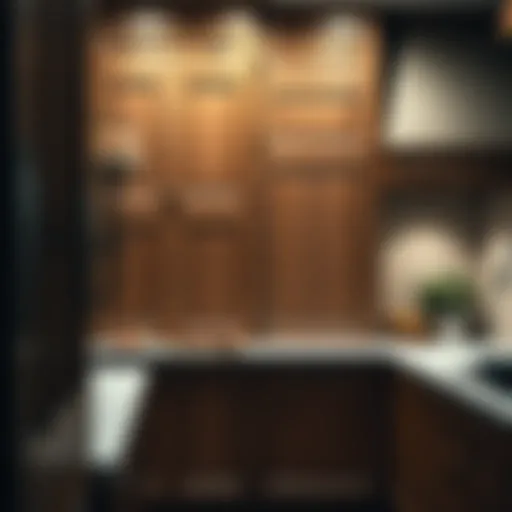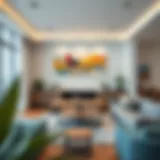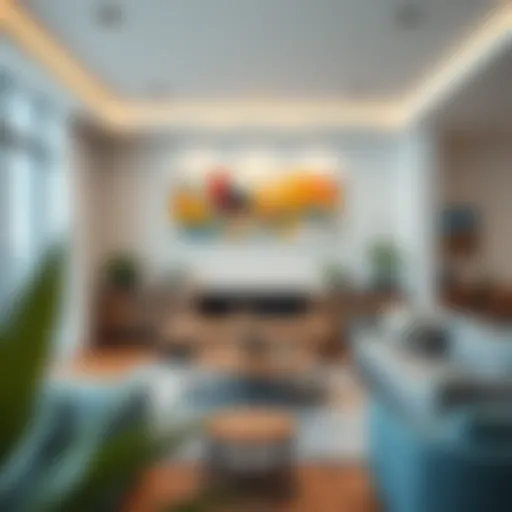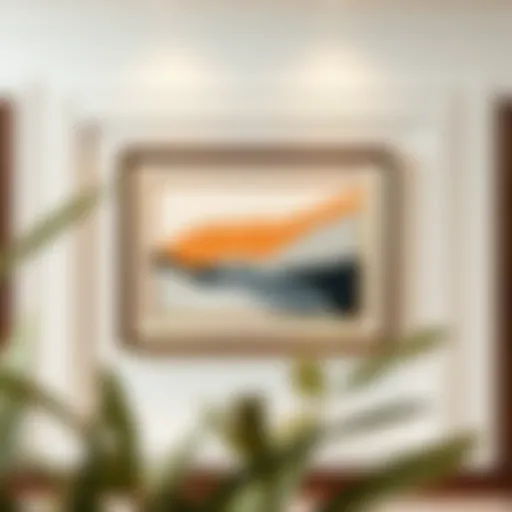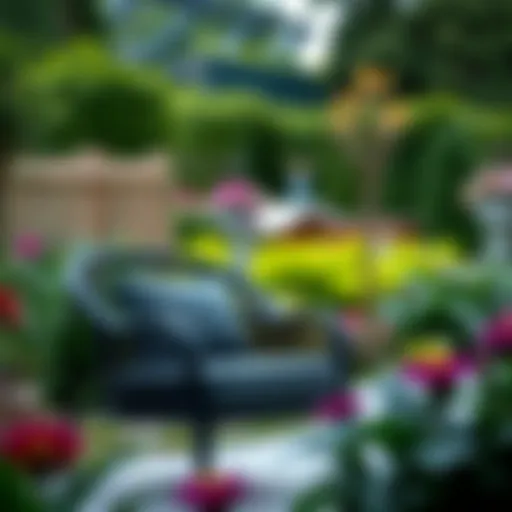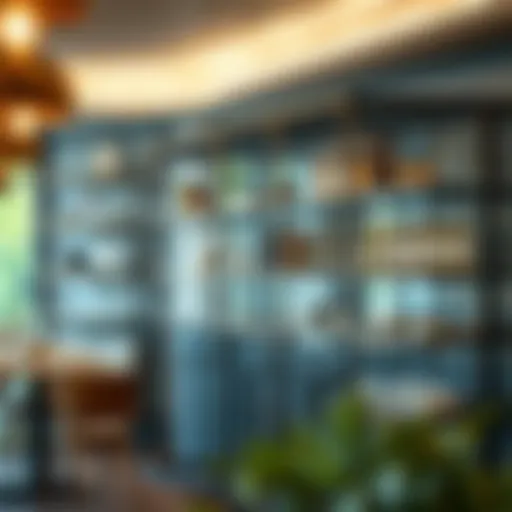The Role of Fake Palms in Modern Interior Design


Intro
In the world of interior design, the blend of aesthetics and functionality reigns supreme. One often overlooked yet increasingly popular element in this realm is the fake palm. These artificial tropical plants have gained traction for their striking presence and low maintenance nature, appealing to a broad audience from homeowners to professional designers. While the allure of the lush, green leaves can be tempting, delving into their role in design offers more than just visual pleasure. This article explores the multifaceted nature of fake palms, looking beyond their superficial charm to understand their practical advantages, emotional resonance, and sustainable sourcing practices.
As people curate their living spaces, the quest for balance between style and practicality becomes paramount. Fake palms serve as a bridge in this pursuit, delivering beauty without the burdens of care often associated with live plants. Through a thorough analysis of current trends and DIY projects, we will also touch on cultural significance and psychological impacts, ensuring a well-rounded perspective on these decorative assets.
Furniture Trends
Current Market Trends
The surge in the popularity of fake palms aligns with larger trends in the furniture market that emphasize sustainability, minimal maintenance, and versatility. According to many designers, these faux plants are increasingly recognized as not just alternatives to real greens, but as essential decor elements that add character and warmth to spaces.
Here are a few trends currently defining the landscape:
- Lush Edges: Interiors are embracing the lush feel that palms bring, with an emphasis on larger, more dramatic fake palms that can act as statement pieces.
- Indoor-Outdoor Flow: Designers often integrate these faux plants into layouts that promote continuity between indoor and outdoor spaces, making them ideal for sunrooms or patios, enhancing the aesthetic without the worry of weather damage.
- Color and Texture: With advancements in materials, fake palms now come in various shades of green, allowing homeowners and designers to match them perfectly to existing palettes.
Popular Styles and Designs
To keep a fresh look, various styles have emerged in the realm of fake palms. Here’s a breakdown of some common designs:
- Tall Floor Palms: These dramatic pieces often serve as focal points, lending a height that draws the eye upward, perfect for minimalistic studios.
- Hanging Palms: Adding a gentle touch from above, these palms create a comforting atmosphere, lending softness to harder architectural lines.
- Arrangements: Incorporating multiple types of fake palms in arrangements brings depth and variety to spaces. A mix of sizes and textures can successfully mimic the diversity found in natural environments.
Incorporating artificial palms into home designs promotes not just aesthetic appeal but also a practical solution to common plant-care issues. While they might lack the aroma of the real thing, their ability to blend seamlessly into modern decor encapsulates a savvy choice for enhancing living spaces.
Foreword to Fake Palm
Fake palms hold a unique space in the realm of interior design. They aren’t just mere stand-ins for the real thing; they represent a blend of aesthetics, practicality, and cultural significance that resonates across various settings. Homeowners and designers often turn to these artificial plants to make a bold statement in a living space or to create a soothing atmosphere. The appeal of fake palms lies in their ability to provide the green touch that many crave while eliminating the headaches that come with keeping real plants alive.
Definition and Overview
Fake palms, or artificial palm plants, are crafted from a variety of materials including plastic, silk, and fabric. They come in numerous sizes and styles, allowing them to fit into almost any space. Their lifelike designs aim to mimic the features of real palm trees—like the graceful fronds and robust trunks—offering an aesthetic diversion that can lift the spirits of a room. What sets them apart is not only their appearance but also their maintenance-free nature, making them an attractive option for busy lifestyles.
By integrating fake palms into home decor, one can achieve a tropical vibe without the commitment of caring for a live plant. Indoor settings often benefit from their ability to create visual interest and provide a refreshing pop of color, enhancing overall room dynamics.
Historical Context
The journey of fake palms in interior design can be traced back several decades. Initially, artificial plants were relegated to being budget-friendly alternatives for those who couldn't afford real foliage or lacked the necessary sunlight. Over time, however, advancements in manufacturing techniques and materials transformed these objects from impractical imitations to sophisticated decor elements.
In the 1970s, for instance, the rise of plastic plants gained traction, as homeowners sought easy-care alternatives in a fast-paced world. By the 1990s, silk foliage began to emerge, boasting more realistic designs. These changes reflected shifting societal attitudes towards home aesthetics and the desire for low-maintenance living environments. Today, fake palms are not merely functional; they carry an air of elegance and style that competes with their living counterparts.
In summary, the significance of fake palms in interior design is multilayered. They serve as a means to beautify spaces while accommodating the demands of modern living. Furthermore, understanding their evolution invites a deeper appreciation for the role they play in our curated environments.
Types of Fake Palms
The world of fake palms is vast and varied, much like the foliage found in nature. This section seeks to elucidate the different types of fake palms available today, highlighting their materials and designs. Understanding these options is crucial for homeowners, renters, and designers looking to create dynamic spaces while benefiting from the unique attributes of artificial palms. The choice of material and design style ultimately influences the aesthetics, maintenance, and overall vibe of a space.
Material Variations
When it comes to fake palms, the material used plays a significant role in their appearance, durability, and cost. Let's delve into the three main materials: plastic, silk, and fabric. Each comes with its own set of characteristics, advantages, and disadvantages.
Plastic
Plastic is perhaps the most common material for artificial palms. The key characteristic of plastic palms is their resilience. They don’t wilt, fade, or require water or sunlight, making them a popular choice among busy homeowners. You can place these palms in areas with bright lighting without fear of damage, and cleaning them is a breeze—just a quick wipe, and they're good as new.
Advantages:
- Durability: Plastic palms hold up well over time, enduring wear and tear better than their counterparts.
- Versatility: They come in various styles, allowing for endless design possibilities.
- Cost-Effectiveness: Generally more affordable compared to natural or silk options, they’re a favorite for budget-conscious decorators.
However, the unique feature of plastic lies in its less-than-realistic appearance. Though some high-end options mimic real palms well, others can look somewhat cheap and synthetic, which may not fit every decor style.
Silk
Silk offers an air of elegance that is hard to overlook. These artificial palms are crafted with detailed attention to replicate the delicate textures and colors found in nature. Their key characteristic is the lifelike look, which makes them a beloved choice in upscale interiors.
Advantages:
- Realism: Silk palms can portray a lifelike quality that can easily fool the eye.
- Aesthetic Appeal: They lend a touch of sophistication when strategically placed in any environment.
On the downside, silk palms require a bit more care compared to plastic ones. They can accumulate dust and might be susceptible to fading if left in direct sunlight too long, which can affect their lush appearance.
Fabric
Fabric palms combine versatility and uniqueness. Unlike traditional plastic or silk, these palms often involve mixed media and can include a range of textures, colors, and patterns. Their key characteristic is the variety they offer in design, allowing homeowners to express their individual style.
Advantages:
- Customization: Fabric palms can be made in different shapes, sizes, and colors.
- Soft Touch: They often provide a more tactile feel, which can soften a space.
However, the unique feature of fabric palms is also their potential drawback. They can be more delicate, requiring careful placement and occasional cleaning that can involve more effort than plastic or silk options.
Design Styles
The design of artificial palms can create diverse atmospheres in any space. Here, we explore two specific styles: realistic imitations and artistic alternatives, giving insight into how each one contributes to interior decor.
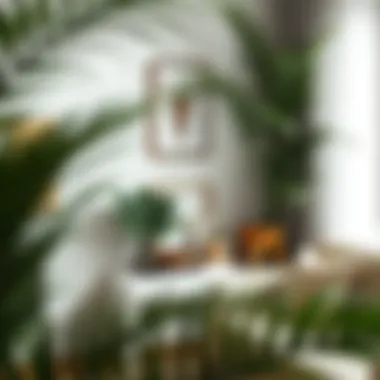
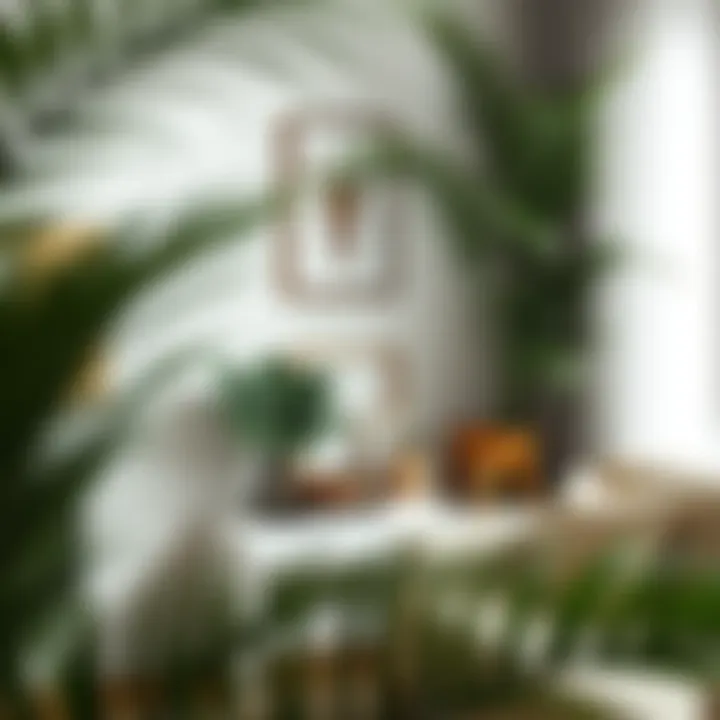
Realistic Imitations
Realistic imitations of palms are crafted to closely resemble their live counterparts, capturing the details of fronds, stems, and leaf textures. This style serves to bring a breath of outdoor freshness into indoor settings.
Benefits:
- Authenticity: They can enhance the aesthetic of a space by creating an authentic botanical feel.
- Versatile Placement: Suitable for any area, from cozy corners to expansive commercial spaces, they adapt beautifully.
Their main advantage is the visual impact they deliver. However, for some, the cost associated with high-quality realistic imitations can be a deciding factor.
Artistic Alternatives
Artistic alternatives to fake palms break away from naturalistic representations, allowing for creativity and unique expression in interior design. These palms often embrace innovative designs, vibrant colors, and bold geometric patterns.
Benefits:
- Creativity: They can act as striking focal points or conversation starters in a room.
- Flexibility in Design: Artistic alternatives can be integrated into a variety of decor themes, particularly modern or eclectic spaces.
While these palms offer a dramatic flair, their non-traditional nature may not be appealing to every homeowner, especially those aiming for traditional or classic aesthetics. Their effectiveness often hinges on the owner's personal taste and the surrounding decor.
Benefits of Fake Palms
The presence of fake palms is more than mere decoration; they bring a multitude of benefits that enhance interior environments significantly. Understanding these advantages can guide homeowners, renters, designers, and even DIY enthusiasts in making informed decisions about their decor choices. From maintenance ease to allergy considerations, fake palms prove valuable in various aspects.
Maintenance and Longevity
One of the standout benefits of fake palms is their effortless maintenance. Unlike living plants that require consistent watering, sunlight, and sometimes even soil management, artificial palms simply need occasional dusting or wiping down. This hands-off care allows busy individuals to enjoy greenery in their living spaces without the commitment of tending to real flora.
Moreover, the longevity of fake palms is a significant consideration. Well-crafted artificial palms, especially those made from high-quality materials like silk or durable plastic, can last for years without losing their charm. Invest in a decorative palm that aligns with your aesthetic, and you may find it remains a staple in your room for a decade or more. This durability translates into a favorable cost-to-benefit ratio over time, as you wont be constantly replacing plants that wither away or require special conditions.
Here are some vital points about the maintenance and longevity of fake palms:
- No water or sunlight needed means less hassle for upkeep.
- Quality materials ensure they stay vibrant without fading.
- Easy to relocate within your space without worrying about soil or roots.
Allergy Considerations
A frequently overlooked benefit of fake palms is their allergy-friendly nature. Live plants can be a haven for allergens like mold spores, dust, and even pollen, which can lead to breathing problems for sensitivities or allergies. On the other hand, artificial palms eliminate this risk entirely. They serve as an appealing alternative for individuals and families who may suffer from allergies while still desiring the aesthetic of greenery in their homes.
In fact, by incorporating fake palms, you're not just enhancing your decor but also fostering a healthier living environment. It's worth paying attention to the materials used in these decorations; opting for non-toxic and hypoallergenic options only strengthens this advantage. Thus, integrating fake palms into your home decor can result in a visually appealing space without compromising your well-being.
"Choosing fake over real plants offers not only aesthetic gains but also reduces allergy triggers in the home."
Consider the following aspects regarding allergy considerations:
- No exposure to mold or pollen from artificial plants.
- An option for households with sensitive individuals or pets.
- Possibility for creating tranquil spaces free from allergy concerns.
In essence, the benefits of fake palms extend beyond their visual appeal. Their low maintenance, durability, and allergy-friendly features collectively seem to make them a sensible choice for enhancing any indoor oasis.
Fake Palms vs. Real Palms
When it comes to decorating spaces, the choice between fake palms and real palms can stir up a lively debate among homeowners and designers alike. Knowing the differences is vital, as it affects not just aesthetics but practicality, cost, and even environmental considerations. This section will peel away the layers of both options and shed light on why understanding this subject is pertinent for anyone looking to enhance their living environment.
Aesthetic Comparison
The visual impact of palms, whether real or artificial, serves a fundamental role in interior design. Stunning as they are, real palms often bring with them an air of authenticity that can be difficult to replicate with their fake counterparts. However, the technology behind fake plants has come a long way. For instance, a well-crafted artificial palm may mimic the intricate details of a real one closely, right down to the subtle variations in color and texture.
Here are a few points to ponder in this comparison:
- Visual Appeal: Real palms tend to bring life to a space. The natural light filtering through their leaves creates movement and shadows that can enhance the mood in a room. In contrast, a high-quality fake palm can also provide visual contrast but lacks the organic variability of real plants.
- Longevity of Aesthetics: Real palms need care—watering, sunlight, and occasional repotting, which means they can become unsightly if neglected. Alternatively, fake palms maintain their appearance year-round, offering consistent beauty regardless of the season.
- Customization Options: Artificial options come in numerous styles, colors, and sizes, making it easy to align with a particular design vision. That said, real palms bring a unique charm that changes with time; they grow, evolve, and can, at times, become a conversation starter—much like a fine wine aged to perfection.
However you slice it, both options have their allure. It boils down to personal preference and lifestyle.
Cost Analysis
From a financial standpoint, the choice between fake and real palms can significantly impact your budget. While the initial investment in a real palm may be lower, the long-term costs can be quite different due to ongoing maintenance needs.
- Upfront Costs: A basic real palm might only set you back a few dozen dollars, but remember that costs rise with size and maturity. On the flip side, a premium artificial palm can range from thirty to hundreds of dollars, depending on quality.
- Maintenance Costs: Real palms need water, soil, fertilizers, and sometimes pest control. Over time, these costs add up, especially if you have a collection of plants. Fake palms, in contrast, don’t require these ongoing expenditures. An occasional dusting and an occasional replace are all you will need to keep them looking fresh.
- Longevity: A good quality fake palm can last for years, while real palms typically have a limited lifespan, depending on their care and environmental conditions. The longevity factor sways many towards fake palms since they offer a potentially better return on investment.
Environmental Impact
The environmental consequences of choosing between fake and real palms warrant careful consideration. Here are some ways both options can sway the green conversation:
- Sourcing Real Palms: Real palm trees absorb carbon dioxide and produce oxygen, contributing positively to the ecosystem. However, unsustainable harvesting practices can lead to habitat destruction and biodiversity loss.
- Artificial Palm Production: On the other hand, fake palms are often made from synthetic materials such as plastic, which can have environmental drawbacks. The production and disposal of these materials might contribute to pollution. However, advancements in eco-friendly materials offer some rays of hope, with manufacturers utilizing biodegradable options or recycled plastics.
- Lifespan and Disposal: At the end of their life, real palms decompose and can benefit soils, while plastic versions contribute to a landfill issue if not disposed of carefully. Thankfully, some brands are adopting a more sustainable approach, focusing on eco-friendly production methods.
"Choosing between fake and real palms is not just a matter of aesthetics; it’s a complex decision that weighs beauty against practicality and environmental integrity."
These three angles—aesthetic comparison, cost analysis, and environmental impact—all intertwine, creating a tapestry of choices that reflect personal values, style preferences, and practical realities when integrating palms into interior design.
Cultural Symbolism of Palms
The cultural symbolism of palms ain’t just a trivial sprinkle of greenery in a room; it embodies deep-rooted meanings across various societies. From ancient times to the present, palms have represented triumph, peace, and hospitality. This makes them not just decorative additions, but conduits of human emotion and tradition. Understanding these layers adds significant richness to the conversation about incorporating fake palms into interior design.
When you think about it, these symbols can greatly affect how we perceive and experience our living spaces. Fake palms symbolize more than just style; they carry significance that can create a unique atmosphere. For homeowners, renters, and designers, recognizing how these elements play into cultural narratives helps in crafting spaces that resonate both aesthetically and emotionally.
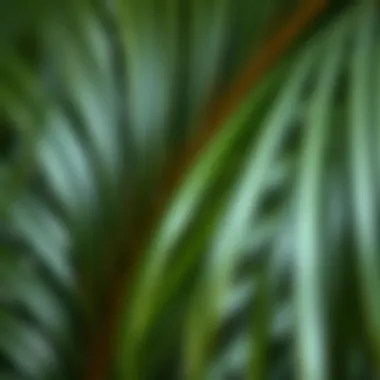
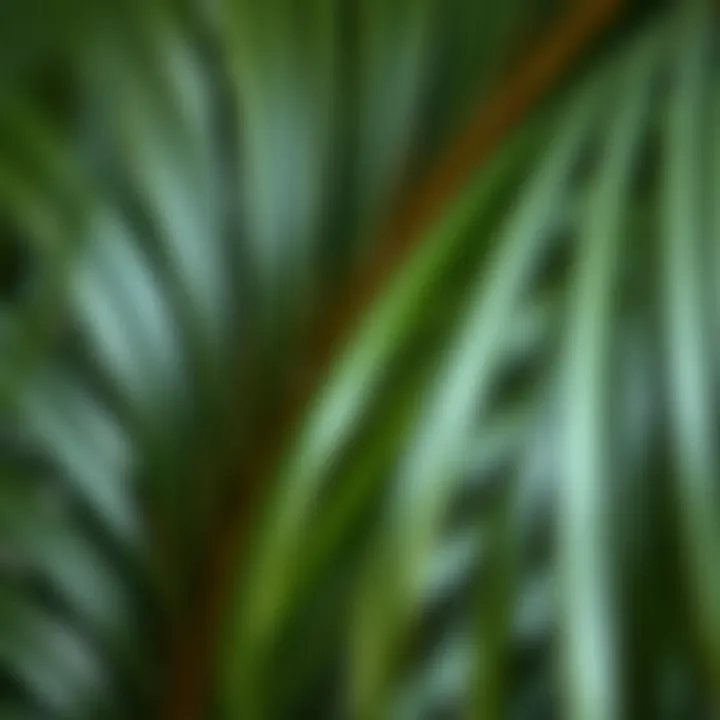
Palms in Different Cultures
Palms are nothing short of icons across many cultures. In Mediterranean societies, the palm tree is often associated with triumph and victory. It’s not unusual to see palm branches used in celebration, especially during festive gatherings. In some Asian cultures, such as in places like Indonesia, palms are seen as a symbol of peace and tranquillity, often used to adorn homes and temples.
- Symbol of Victory: The ancient Romans awarded palm fronds to victors in athletic contests.
- Welcoming Spirit: In many Middle Eastern cultures, palms signify hospitality and richness of spirit, often planted near homes to create a welcoming aura.
- Sacred Significance: In Hinduism, palms are regarded as sacred, associated with the goddesses of prosperity and fertility.
This varied symbolism shows how incorporating fake palms can bring not only a design element to a space but also tie in the rich narratives that resonate with individuals in these cultures. Think about the feeling you want to evoke in your space; choosing the right palm design can speak volumes.
Significance in Modern Design
In the realm of modern design, palm trees have transitioned from mere natural elements to symbols of a relaxed, exotic lifestyle. They evoke the essence of tropical beaches or lush tropical forests, regardless of one's actual geographical location. With the rise in popularity of indoor gardening and biophilic design principles, fake palms allow for the aesthetic without the work.
Palms can enhance spaces in the following ways:
- Emulating Nature: They contribute to a serene atmosphere, mimicking the peacefulness of natural landscapes.
- Versatile Style: From minimalist designs to eclectic styles, palm trees can complement a wide array of aesthetics, marrying well with both rustic and modern themes.
- Cohesion in Space: Using palms can link different areas of a home or venue, bringing a cohesive look to the interior decor.
Ultimately, choosing artificial over real palms can free up space and bloody time. For instance, you might place a lifelike fake palm next to a sunlit window, injecting a hint of tropical flair without the fuss of watering or care.
"The palm tree serves as a bridge between cultural heritage and modern aesthetics; it resonates legend and lifestyle simultaneously.”
The next time you're pondering a decor piece for that nook in your living room or a centerpiece for a restaurant, consider a palm. Whether you're after nostalgia or a nod to modernity, these fake palms can deliver on both fronts.
Practical Applications in Interior Design
The role of fake palms within the realm of interior design goes beyond mere decoration. When thoughtfully integrated into living spaces, these artificial plants can transform an area, offering both visual appeal and subtle psychological benefits. The attractiveness of fake palms lies in their ability to mimic the lushness of real palms without the maintenance headache. As this article unfolds, we'll explore specific applications that underscore their practicality, style, and contribution to modern interiors.
Enhancing Space and Style
Fake palms enhance the ambiance of a room, delivering a tropical vibe even in the most urban settings. They can work miracles, turning an average room into a chic sanctuary with just a few strategic placements. For instance, a oversized fake palm can serve as a focal point in a minimalist living room, breaking the monotony of boards and walls. Alternatively, smaller palms can complement a coffee table setup or fill empty corners that typically go unnoticed.
The resilience of these faux plants means that design choices can revolve around personal taste rather than worrying about sunlight availability or watering schedules. Whether creating a serene atmosphere or an energetic focal scene, the styles and variations available allow for truly unique artistic expressions, appealing to a broad array of tastes and preferences.
Guidelines for Placement
Indoor Settings
When talking about indoor settings, the contribution of fake palms becomes more evident. They provide an infusion of nature, which can be a refreshing contrast to technology-heavy environments. In the context of a home office, for instance, a well-placed fake palm can inspire creativity and reduce stress levels. The greenery acts almost like a breath of fresh air amidst the clattering of keyboards and the constant gaze at screens.
One key characteristic of indoor settings is their ability to maintain a consistent look year-round. Unlike real palms that might shed leaves or fade, fake palms maintain their vibrant appearance regardless of the external factors. This is particularly advantageous for people who are on the go and might neglect regular plant care. Moreover, indoor settings allow for a diversity of sizes and styles, granting freedom in design choices—from grand, tall palms to dainty tabletop varieties.
Outdoor Settings
Turning our gaze to outdoor settings, the use of fake palms takes on a different flavor. These settings provide an escape to a sunny paradise, making any backyard or balcony feel like a holiday retreat. A key advantage here is the resilience of synthetic materials, engineered to withstand the outdoor elements without fading or deteriorating. This makes fake palms a reliable option for enhancing the exterior without the worry of wear and tear.
Moreover, having fake palms outdoors allows homeowners to craft an inviting environment for entertaining guests. Picture a spacious deck furnished with lounge chairs, set against a backdrop of strategically placed fake palms—the atmosphere instantly becomes casual yet elegant. However, while they add vibrancy, the challenge lies in ensuring they complement other outdoor elements. Choosing sightings harmoniously that align with existing decor is essential for achieving a cohesive look.
In summary, whether indoors or outdoors, the practical applications of fake palms are vast and impactful, offering novel ways to elevate personal spaces. Not only do they fulfill aesthetic needs, but they also cater to practical concerns such as maintenance and environmental adaptability.
Psychological Effects of Fake Palms
The presence of fake palms in a living space goes beyond mere decoration; they carry psychological implications that can significantly affect how occupants feel within that environment. This section aims to elucidate these psychological effects, providing insight into how the integration of artificial greenery can alter moods, enhance ambiance, and foster a sense of well-being.
Impact on Mood and Atmosphere
When you think of palm trees, images of sunny beaches and tropical vacations often spring to mind. Incorporating fake palms into interior design can evoke these same feelings of tranquility and relaxation. Just picture yourself walking into a room adorned with lush, green palm foliage; it has a unique way of calming the mind and lifting the spirit. Studies have shown that greenery, even in its artificial form, can bring about a sense of peace and reduce stress levels.
Moreover, the colors associated with fake palms—vibrant greens against earthy browns—have a way of creating a harmonious and inviting atmosphere. This infusion of nature-inspired elements doesn't just beautify a room; it can shift perceptions of space, making tight quarters feel more open and breathing life into subdued areas. You could say that fake palms act as a psychological oasis, inviting relaxation amidst a hectic lifestyle.
"The scent of nostalgia often lingers with fake palms, as they transport us to memories of summer, vacations, and leisurely days."
These artificial plants, therefore, play a dual role: they serve as decoration while also impacting our emotions. Utilizing fake palms in places such as living areas or bedrooms can help create a tranquil environment conducive to relaxation or social interactions.
Creating a Sense of Comfort
Adding fake palms can heighten the feeling of comfort in a space, making it both visually appealing and emotionally affirming. This stems from the psychological principle that humans are naturally drawn to nature. Fake palms can serve as a bridge to the natural world, allowing homeowners to enjoy the beauty of flora without worrying about maintenance or environmental challenges.
The tactile quality of a fake palm can only amplify the sense of comfort. Users often find themselves running fingers through the leaves or aligning them to achieve the perfect aesthetic—this engagement can foster a connection to the decor that helps individuals feel more at home.
- Ideal for Urban Settings: In bustling cities, where nature can feel distant, fake palms bring a bit of greenery indoors, counteracting the concrete chaos.
- Versatile Accompaniments: They can complement various design styles, whether contemporary, bohemian, or minimalist, thus integrating seamlessly into your decor while buoying comfort.
By strategically placing these decorative items, one can also dictate the social dynamics of a room. For instance, fake palms can encourage gatherings or provide a tranquil spot, fostering conversations and connections amongst family and friends. In essence, they create not just a space but a sanctuary.
Relevant Resources
By understanding the psychological effects of fake palms, one can harness their potential, transforming any interior into a refuge of comfort and positivity.
Sustainable Practices in Sourcing Fake Palms
The demand for fake palm trees in interior design has surged, but with this popularity comes an imperative to scrutinize the sustainability of their sourcing and manufacturing processes. Making informed choices regarding artificial palms is crucial not only for aesthetics but also for promoting ecological health. As homeowners and designers recognize their roles in mitigating environmental issues, the significance of sustainable practices becomes even clearer.
Eco-Friendly Materials
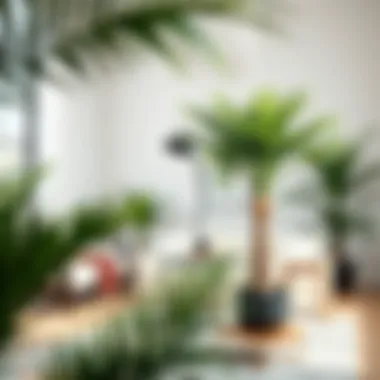

When it comes to fake palms, the materials used in their construction are foundational to sustainability. Traditional plastics, often derived from fossil fuels, have raised considerable concerns regarding their environmental footprint. Today, many manufacturers are looking beyond conventional materials. Some notable eco-friendly options include:
- Recycled Plastics: Transformed waste materials can provide a second life to plastics, reducing the overall need for virgin resources.
- Biodegradable Fabrics: Options such as hemp or organic cotton can cover fake palms, allowing them to decompose more naturally at the end of their life cycle.
- Sustainable Plastics: Innovations in bio-based plastics made from renewable sources like cornstarch offer similar functionality without the long-term implications of petroleum-based products.
By prioritizing eco-friendly materials, interior designers can create beautiful spaces that align with sustainable values. Using these materials not only decreases the carbon footprint but also signals to the consumers a growing awareness of environmental stewardship.
Ethical Manufacturing Processes
Sourcing fake palms also extends beyond materials to the manufacturing processes. It's essential to understand the ethical implications involved in production. Factors to consider include labor practices, energy consumption, and waste generation. Here are several principles that can guide ethical manufacturing:
- Fair Labor Practices: Checking that workers are compensated fairly and work in safe conditions is critical. Ethical brands often have transparent supply chains that allow consumers to trace their products back to the source.
- Energy Efficiency: Manufacturers can invest in technologies that use less energy during production. Strategies could involve using renewable energy sources or optimizing machinery for reduced power consumption.
- Waste Reduction Initiatives: Companies focusing on sustainability often implement plans to minimize waste, such as recycling scrap materials or using closed-loop systems to reuse water in production.
By consciously choosing manufacturers who adhere to ethical practices, designers and consumers alike can foster a market that prioritizes sustainability.
"The choices we make in interior design have a ripple effect. By opting for sustainable and ethically sourced materials, we can create spaces that are not only beautiful but responsible."
It is evident that the move toward sustainable practices in sourcing fake palms isn't merely a trend—it's a necessity. Ultimately, the decisions we make today in our interiors will influence both our living spaces and the broader environment for generations to come.
DIY Projects Involving Fake Palms
When it comes to adding charm to our living spaces, fake palms often find a special place in our hearts and homes. They not only offer the lush beauty of greenery but also allow for creative expression through various DIY projects. The importance of DIY projects involving fake palms cannot be overstated, as they provide homeowners, renters, and designers an opportunity to personalize their decor while reaping practical benefits.
Getting your hands dirty with some DIY projects can turn a regular room into a vibrant space where creativity thrives. It fosters a sense of ownership and satisfaction that store-bought decor rarely offers. Plus, considering the broad appeal of fake palms, it’s no wonder so many individuals are diving headfirst into creating customized pieces that reflect their unique taste.
Creating Custom Decor
Custom decor items that incorporate fake palms can easily elevate the aesthetic of your space. From creating stunning table centerpieces to crafting wall hangings, there’s simply no limit to the imagination. For instance, think about assembling a tropical-themed wreath for your front door or creating a dramatic hanging arrangement of palms that cascades from a shelf or ceiling.
- Centerpieces: Consider a clear glass vase filled with stones and faux palm leaves. This adds an earthy touch and creates a lively focal point for dining or coffee tables.
- Wall Art: Frame smaller fake palm fronds and hang them on the wall. This unconventional approach brings a touch of nature indoors without overwhelming the senses.
- Seasonal Decor: Change it up with the seasons! Replace palm elements with seasonal flowers or decorations, maintaining the same structure while refreshing the look.
By employing simple yet effective techniques, anyone can craft decor pieces that are uniquely their own. Moreover, most of these can be done with readily available materials, making the process even more enjoyable.
Combining with Other Decor Elements
Fake palms are versatile in nature, allowing them to mix harmoniously with various other decor elements. This combinatory approach can harmonize different textures, colors, and styles within a single space. For example, consider the following:
- Mix with Real Plants: Placing fake palms alongside real tropical plants can create depth and visual contrast. The greenery forms a lively backdrop, while the fake palms add consistency throughout the design.
- Use in Terrariums: Incorporating small artificial palms in a terrarium can give it a unique touch. They can flourish within the artificial environment, standing out amid the miniature landscape, which is often rife with real plants, rocks, and soil.
- Pair with Fabrics: Mixing fake palms with patterned textiles, such as cushions or curtains featuring tropical motifs, will create a cohesive look that speaks to a calm and inviting atmosphere.
Creating a blend of fake palms and other decor pieces not only enhances visual appeal but also deepens the connection between spaces and the decor. This layering approach invokes warmth and a welcoming vibe that resonates with most homeowners.
"The richness of decor lies in its ability to reflect the personal style of its inhabitants, and combining distinct elements can paint a vibrant picture of home."
In summary, DIY projects involving fake palms open up a wealth of creative opportunities, inviting you to engage with your space in a more meaningful manner. With a bit of imagination and effort, these palms can turn into stunning decorative features, elevating the ambiance of any room.
Critiques and Misconceptions
In the realm of interior design, fake palms often find themselves at the center of heated debates, leading to various critiques and misconceptions. Understanding these issues not only enriches the conversation around artificial plants but also helps homeowners and designers navigate their choices more effectively. This section aims to debunk myths surrounding fake palms, clarify benefits, and shine a light on cultural preferences, thereby providing a well-rounded view of artificial palms in interior settings.
Addressing Common Myths
One of the most persistent myths about fake palms is that they lack the charm and liveliness that real plants bring to a space. Critics argue that no amount of craftsmanship can replicate the vibrancy of a living plant, dismissing fake palms as merely decorative objects devoid of soul. However, this perspective doesn't consider the advancements in design technology, which have led to incredibly realistic replicas.
Fake palms made from high-quality materials can mimic not just the appearance but also the textures of real leaves, offering an aesthetic that appeals to many homeowners. Moreover, these artificial counterparts provide an advantage that real palms cannot compete with: longevity without the need for care.
- Myth 1: Fake palms look plastic and lack detail.
- Myth 2: A natural touch is always superior.
- Myth 3: They are environmentally harmful because they’re not real.
Each of these myths requires careful consideration. For instance, while real palms might be considered more dynamic, the endless maintenance they entail can be a major drawback for busy homeowners.
Understanding Cultural Preferences
Cultural perspectives on palms—which have deep symbolic meanings in many societies—also shape the debate around the use of artificial versions. In regions where palm trees are abundant, such as tropical climates, the mere sight of fake palms can elicit mixed feelings. For some, these copies can evoke nostalgia or a longing for their homeland, while for others, they may represent an inauthentic experience.
- Cultural Symbolism: In many cultures, palms signify peace, fertility, and victory. This richness can be diluted when they appear in artificial forms.
- Regional Preferences: In places where nature is embraced, like the Caribbean, there might be a strong bias towards real greenery, while urban centers may favor the practicality of fake palms.
- Aesthetic Interpretation: Designers must consider cultural contexts when using fake palms. They can communicate a sense of place and authenticity, but only when applied thoughtfully.
Understanding these cultural nuances can enrich the decorating narrative and offer insights into why fake palms may or may not be embraced in a particular interior design scheme. Ultimately, recognizing both critiques and misconceptions helps in appreciating the multilayered role fake palms can serve in various living spaces.
The End
The discussion surrounding fake palms in interior design reflects a significant aspect of modern aesthetics, practicality, and even psychological well-being within home environments. By focusing on the choice of using artificial palm plants, homeowners and designers tap into a blend of style and functionality that can elevate any space.
Recap of Key Points
Fake palms are not merely decorative elements; they serve various purposes:
- Aesthetic Versatility: Available in numerous styles and materials, fake palms can complement diverse interior designs, from minimalistic to tropical-themed.
- Low Maintenance: Unlike their live counterparts, these artificial plants do not require watering, pruning, or direct sunlight—ideal for those with busy lifestyles or for spaces lacking natural light.
- Health Considerations: They do not contribute to allergies or require any special care, making them suitable for households with sensitive individuals.
- Cost-Effectiveness: Their initial price may be higher than real plants, but the longevity and lack of ongoing care costs make them a more economically sound choice over time.
Understanding these attributes equips homeowners not just to decorate, but also to create an inviting atmosphere tailored to their specific needs and preferences.
Future Trends in Fake Palm Usage
As we progress into an era where aesthetics meets sustainability, the future of fake palms in interior design is likely to evolve. Key trends to anticipate include:
- Sustainable Materials: Increased emphasis on eco-friendly production methods and materials, such as recycled plastics, will become more prevalent as consumers demand environmentally responsible options.
- Technologically Enhanced Designs: Advancements in manufacturing technology may result in even more realistic fake palms, fooling the eye and elevating the design space further.
- Integration with Smart Home Systems: Future iterations of home decor could include plants that incorporate smart technology, allowing homeowners to coordinate lighting and ambiance around their decor choices.
- Cultural Representations: As global design influences continue to blend, we might see fake palms that honor cultural significance from various regions, integrating symbolic elements into their designs.
In-so-far as fake palms serve to bolster style and comfort within a home, their role is undeniably potent in shaping contemporary living spaces. Awareness of the innovations on the horizon further ensures these designs remain relevant, attractive, and deeply aligned with our evolving lifestyles.
"The decisions we make about our living spaces reflect our values, what we cherish, and how we choose to engage with the world around us."
By fostering a balance between aesthetics and functional benefits, fake palms represent a savvy choice in interior design, poised for a promising future.

